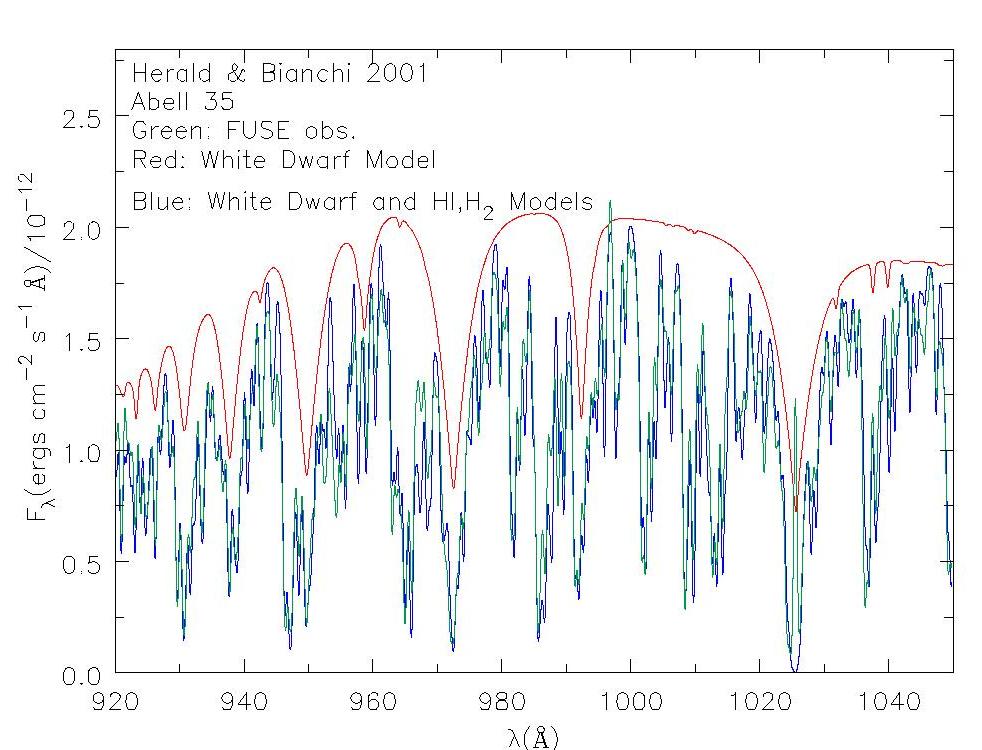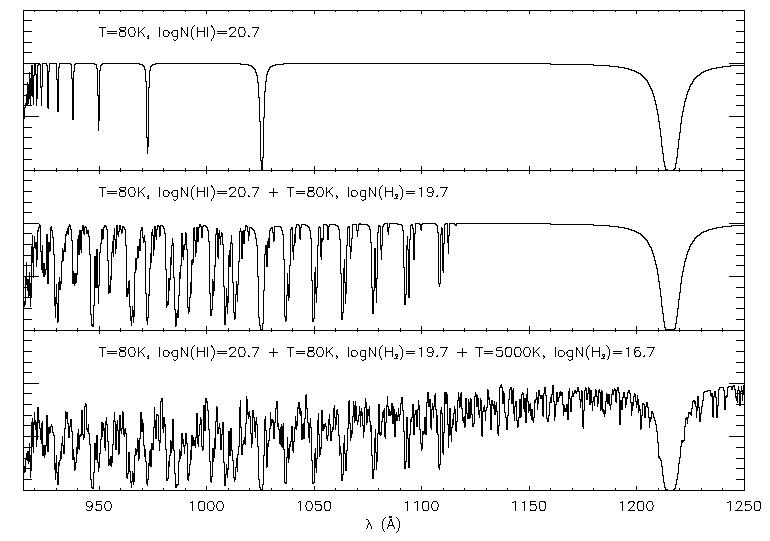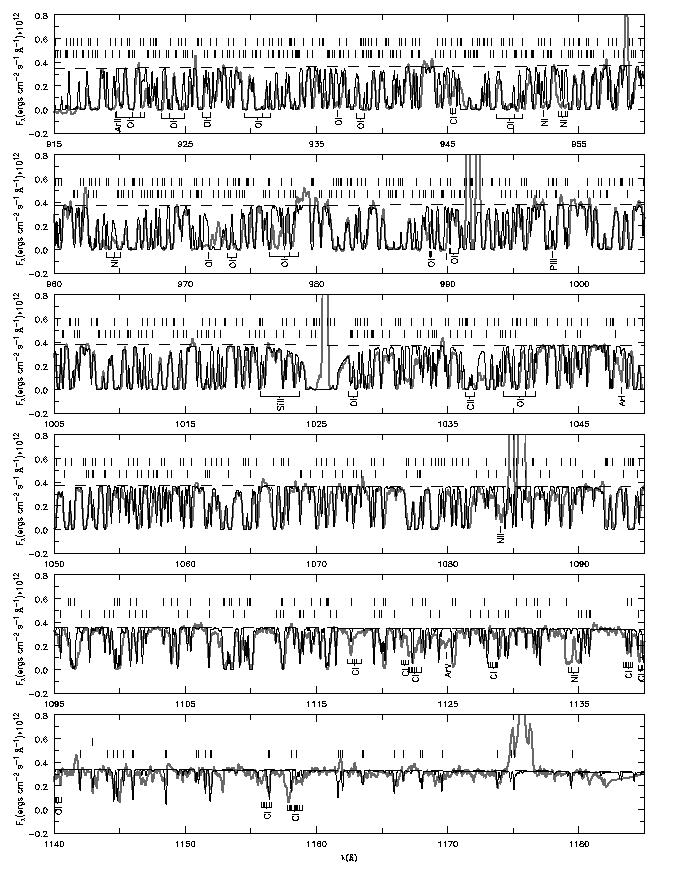![]()
Grid of synthetic atmosphere models for H-deficient [WCE] CSPN from Graziela Keller 2011, PhD Dissertation, Keller et al. 2011, MNRAS, 418, 705:
Hdef grid
A grid of 199 models for H-deficient CSPN, covering a stellar temperature range from 50,000K to 200,000K,
with various values of mass-loss rate, transformed stellar radius, and wind velocity. The grid provides line-blanketed spectra
with wind
from 900Ang to 50,000Ang (continuum spectrum from 300Ang), at varying spectral resolution, computed with the CMFGEN code.
The synthetic spectra are available, as well as many diagnostic plots, from
Keller et al. (2011, MNRAS, 418, 705)
![]()
What's the new discovery?
Using NASA's Far Ultraviolet Spectroscopic Explorer
(FUSE) satellite, we have determined that a strong
``P Cygni'' line seen
in the spectra of hot Central Stars of Planetary Nebulae (CSPN)
originates from highly ionized neon in the star's atmosphere. This is
an important discovery, because the amount of neon in the star's
atmosphere at this phase in the stellar life,
is a clue to its past, and future, evolution.
The identification of this feature will help us understand the
advanced stages of evolution of stars like our Sun, as well as how
these stars impact the evolution of the galaxies they inhabit.
How was it discovered ?
A "spectrum" is a graph of how much energy is emitted at each
wavelength (different wavelengths correspond to different energy,
or "colors").
The first figure shows the FUSE spectrum of a very hot CSPN,
NGC 2371. Some of the features seen in a star's spectrum come from
ions of different elements in the star's atmosphere (an "ion" is an
atom which is missing some of its electrons). These features have
a typical profile (called P Cygni profile)
when the star has a strong "stellar wind" - i.e., it when it
is expelling material from its surface into space. Two such features
are seen here - the one on the right is due to OVI
which is oxygen with 5 of its electrons missing. We
discovered the feature on the left to be caused by NeVII
("neon-seven", or neon missing 6 electrons), and not by CIII,
as was widely believed prior to our work. Ascribing this line
to CIII did not seem consistent with other clues suggesting that
the star is extremely hot, and the transition energy of the CIII
line is a bit off the observed transition, so that attributing
the line to CIII would also imply huge velocities in the stellar
winds, that could hardly be explained.
We use computer programs (called "stellar atmosphere codes"), which simulate conditions in the star's atmosphere, to determine the star's physical characteristics, such as its temperature and the chemical composition of its atmosphere. We input these physical characteristics, and the program calculates a synthetic spectrum, which we compare to the observed spectrum of the star. When the computed spectrum matches all the observed features, we know that the input parameters are the physical parameters of the star.
Ions such as OVI and NeVII, which are atoms missing many electrons, are signs of very high temperatures in the star's atmosphere. The electrons are kicked out from their atoms by high energy photons. Using stellar atmospheres codes, we've determined that the atmosphere of NGC 2371 is extremely hot - about 135,000 degrees Celsius (the Sun is only 5000 degrees!), making it one of the hottest stars known.
How do we ``take the temperature'' of a star?
Spectral features from ions can act as thermometers, giving us precise
indication of the star's temperature. In the next figure, we show
calculated spectra for stars spanning a wide range of temperatures. In the
spectra of the hottest stars, we see a strong OVI feature.
But for cooler stars, the signature of OVI
gets weaker and we see instead signatures of OV and OIV.
What happens is that in
these cooler atmospheres, the majority of the oxygen atoms have been
stripped of fewer electron.
In the
coolest stars OVI doesn't appear at all.
When does Neon show up?
Stars with masses similar to the Sun or larger will become CSPN late in their
lives. Most CSPN fall into two categories - "hydrogen-rich" (which
have abundances of the chemical elements like the Sun)
or "hydrogen-deficient" (which have less
hydrogen and more carbon, oxygen - and neon). Astrophysicists
have developed "stellar evolution codes", which simulate the nuclear
reactions going on in the star's core, and how the chemical make-up of
the interior of the star changes. Part of the products of the
innermost nuclear fusion are brought to the stellar
surface, changing the star's appearance. Stellar evolution codes have
been able to explain the chemical abundances seen in "hydrogen-rich"
CSPN for a while, but the "hydrogen-deficient" stars were still a bit of a
puzzle. A stellar evolution scenario recently developed which
could explain the high carbon and oxygen abundances seen in these
stars, also predicted that the neon abundance would be
enhanced. But there was a problem
for testing this theory with extremely hot CSPN - no strong neon
features (or, "diagnostics") had been identified in their spectra!
The neon abundance in a stars' atmosphere is an important clue into
which evolutionary path it is on.
You can see the details of our study of this neon feature here.
![]()



